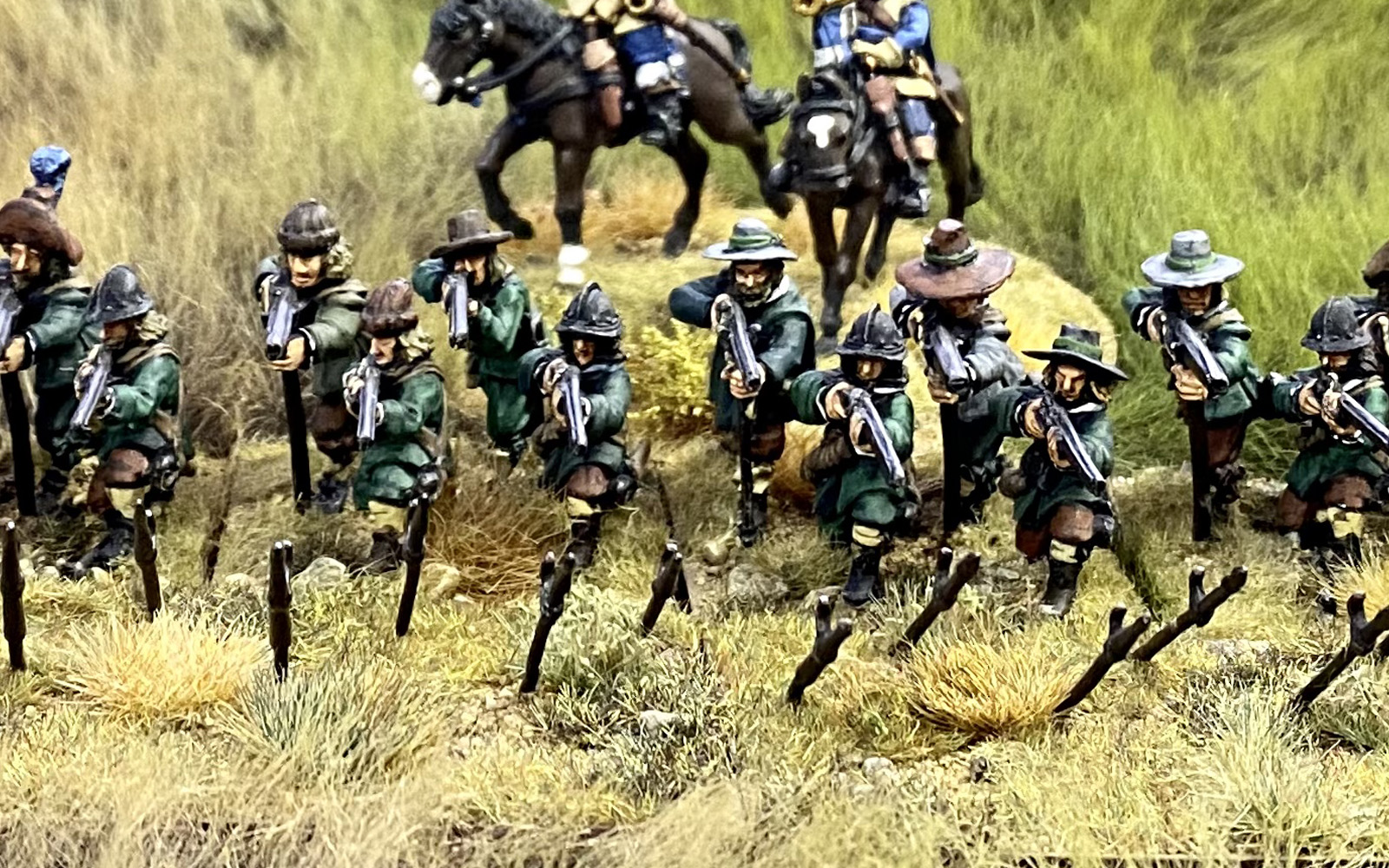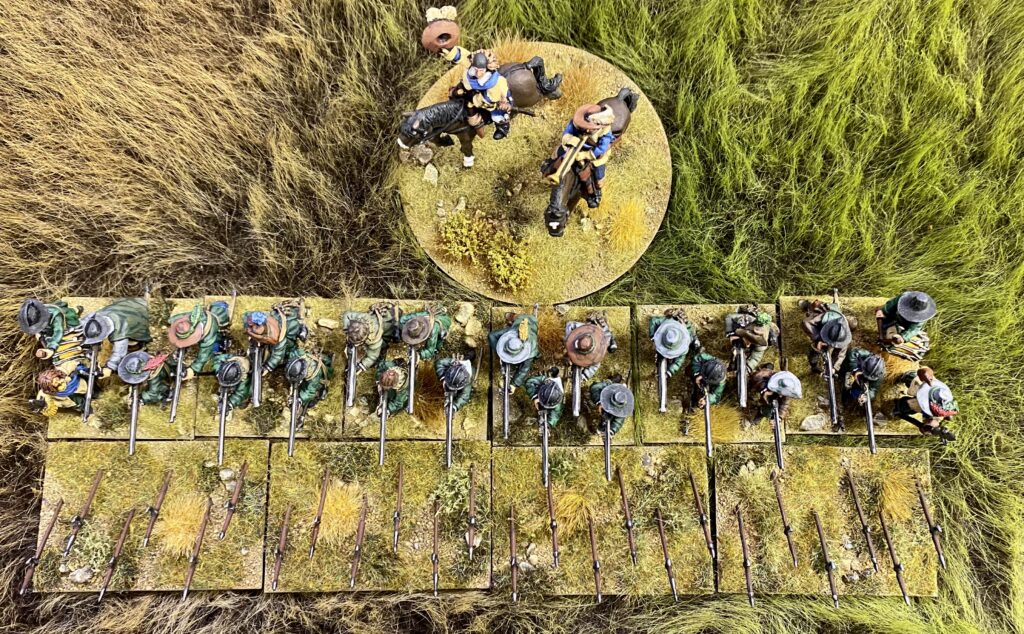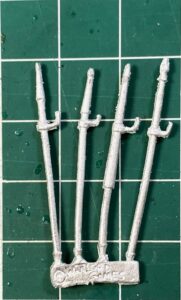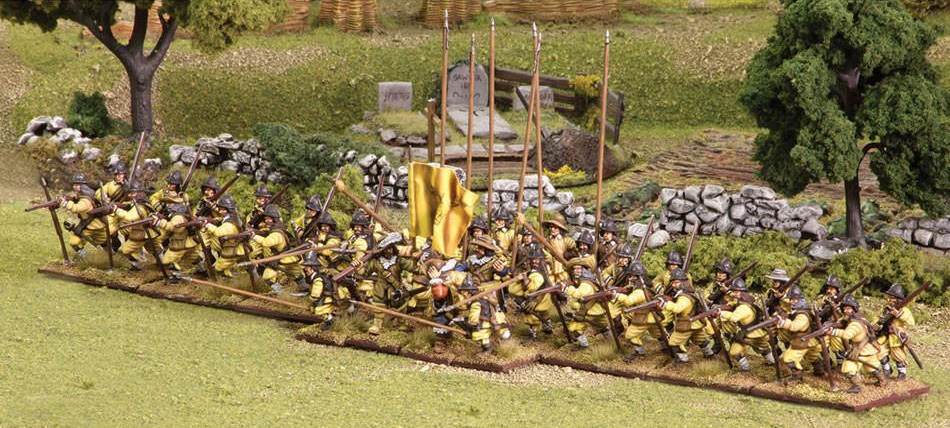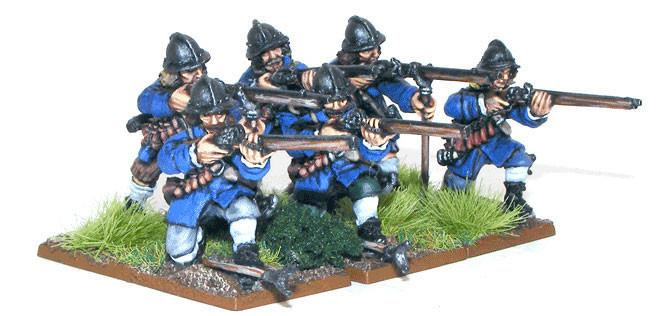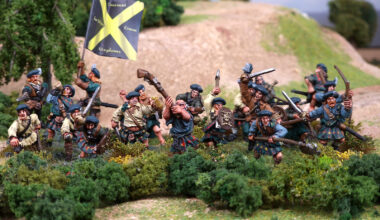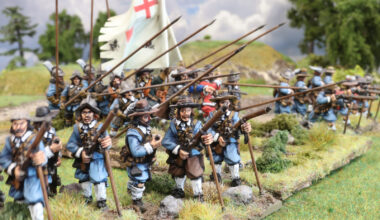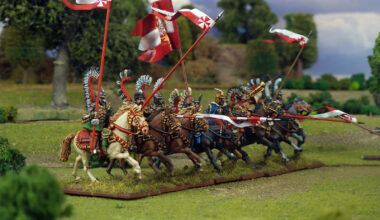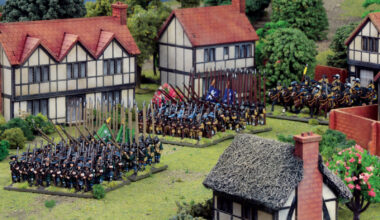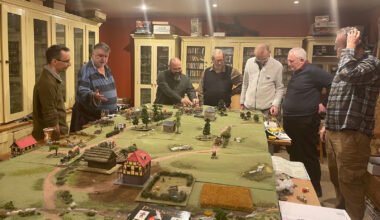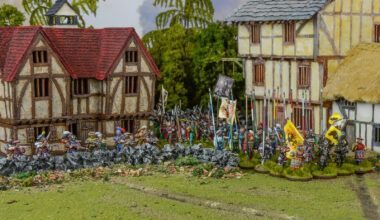This article was penned by regular contributor Andy Bartlett, of the Friends of General Haig, also known as the Worcester Wargames Club. The article originally appeared on his blog – which is dedicated mostly to tabletop recreations of 17th-century warfare. You can find it here »
By the one end it is made fast in the ground in such a manner that the other may lay out so it may meet the breast of a horse where by a body of musketeers is defended as with a palisade against the rude charge of a squadron of horse…
from James Turner’s 1683 book ‘Pallas Armata, Military Essayes of the Ancient Grecian, Roman and Modern Art of War
Background
Swine feathers, or Swedish Feathers, were portable stakes used by shotte-armed foot in the 17th century to create temporary defences against mounted troops. The idea of missile-armed foot troops having some form of defence against charging cavalry was not a new idea in the 17th century. I’m sure that many of you will immediately think of Henry V’s army at Agincourt with the English and Welsh bowmen using stakes to help defend themselves against French mounted knights.
By the 17th century, musket-armed infantry were of course still vulnerable to enemy cavalry. Although their pike-armed colleagues were intended to be one form of defence, the idea of pre-prepared stakes was (re-)introduced during Prince Maurice’s military reforms at the turn of the 16th/17th centuries. Each stake was made of a stout, thick pole, between 4 and 6 feet long, with a metal point at one end to aid in planting it in the ground, and a spear point at the other with which to fend off the enemy. It may have got the name ‘swine feather’ because of its similarity to a boar-spear, a very stout spear used in the hunting of wild boar.
The Swedes, who were fighting the fearsome cavalry of the Polish-Lithuanian Commonwealth in the early 1600s, needed ways to defend their musketeers. They appear to have been early adopters, and Gustavus Adolphus (King of Sweden from 1611 to 1632) ordered enough swine feathers to equip eight regiments of infantry in the early 1620s. It was probably because of this reason that they also became known as Swedish Feathers.
Technical Details
Although swine feathers are mentioned in a number of military treatises of the time we know frustratingly little about the details of their construction and use. From the descriptions of them in literature, and from some tantalising 1/6 scale contemporary models that have survived, we have some idea of how they may have looked. One interesting possibility is that in some form the stakes incorporated a feature that allowed them to be used as either a musket rest or as a stake. While this makes sense in reducing the number of things a musketeer was expected to carry, it does rather limit functionality – when placed in the ground as a stake, it couldn’t be used as a rest to allow the musketeer to continue firing, and vice versa.
Use In Action
Evidence for their actual use in actual engagements is quite difficult to come across. Charles Singleton has written a very interesting piece that describes their employment in the British Civil Wars. The Kadrinazi blog also has some excellent references for the use of Swine feathers on the continent.
It was following reading about their use at the battle of Gniew/Mewe in 1626, between the Swedes and Poles, that I started to think about how I might represent them on the miniature battlefield. In this battle, Gustavus Adolphus needed to field his musketeers without their protective pikemen because of difficult ground. To provide the musketeers with some defence the Swedish King issued the musketeers with the swine feathers that were normally carried in the baggage train. Although there are no details of their use or impact in the battle, it is interesting to note that an engineer in the Polish army at this time, Wendelin Schildknecht, wrote about the use of swine feathers, and their effectiveness against the Polish cavalry. He comments that he was surprised the swine feathers were only used for a couple of years by the Swedes, and he’s not sure why their use stopped, other than perhaps the inconvenience of expecting the musketeers to carry the extra encumbrance.
Modelling Feathers
I suppose the easiest solution would have been to grab some wooden cocktail sticks and to have used these to represent Swedish Feathers. However, I Warlord Games have some rather lovely looking Swedish Feathers available in their 28mm Pike & Shotte range. These look to be based upon the original 1/6 scale surviving models and include the ‘musket rest’ feature. Even though I’m not convinced that they were used in a dual role, these white metal models were too nice not to use! An order to Warlord HQ was swiftly followed by the delivery of a good supply of swine feathers.
Deciding how to base them took a bit of thought and experimentation. As far as I know there is no account of how they were placed when in the ground. I decided to have as many ‘feathers’ as I had figures in a unit of shotte, and to have them deployed, also like my figures, in two ranks.


I decided to make separate bases of deployed stakes that could be added on to the table, in front of units of shotte, to represent deployed swine feathers. Using blu-tack I tried them on some different configurations of bases:
- 20mm deep bases would minimise how much they might get in the way, but I was concerned they might tip over more easily, and the bendy white metal stakes would be less protected by this short base.
- 40mm depth of base seemed ideal. I suppose it would have made sense to use 40mm square bases, the same that I use for my foot.
- However, 60mm frontage, 40mm depth allowed a compromise – it would reduce the number of additional bases that would need to be ‘faffed about’ with.
I had a selection of 60x40mm, 2mm thick, MDF bases in my hobby hoard. After a small amount of cleaning up, to remove flash, I attached the feathers to the bases ready for priming and painting. On each base, I marked where each feather would need to go so they were evenly spaced across the base (a cutting mat with 10mm squares helped with this).
To attach to the base I used a pin vice with a 0.5mm drill bit to make small holes in the base. The stakes needed to be at an angle, so I started with a perpendicular hole and then drilled at an angle once I had made a sufficient indent. Each small hole in the MDF base was then enlarged slightly with a round needle file, and each feather was glued in place with super glue and spray activator.
I primed the feathers with a dark brown spray paint (I don’t often use spray, but it was a nice day outside). This gave a good prime and dark base coat. I paint the pikes for my Swedish army black based on the protective paint that is believed to have been used on them (see Lion of the North, Volume One by Michael Fredholm Von Essen), so it would seem logical for the feathers to be treated in the same way. I was, however, worried that they might not show up very well on the table if they were black or dark grey. I therefore opted for a reddy-brown colour for the wood, and dark metal for the metal parts.
Once my regular basing was added I then had enough sets of swine feathers to deploy with each of my Swedish units of shotte. I was pleased with the results so I decided to create a few ‘vignette’ bases to add to the regular bases. These have the troops actually setting up the stakes, and also wounded horses or soldiers between the set-up stakes.




The To Kill A King Pike & Shotte supplement includes rules for all sorts of defences, including swine feathers, a snippet of which is shown below.
It will be exciting to find out how well my Swedish shotte with swine feathers cope without their protective pikemen on the battlefield!
by Andy Bartlett (FOGH)
Musketeers of the Thirty Years War
These miniatures are ideal to deploy on the battlefield behind protective swine feathers in games of Pike and Shotte.
